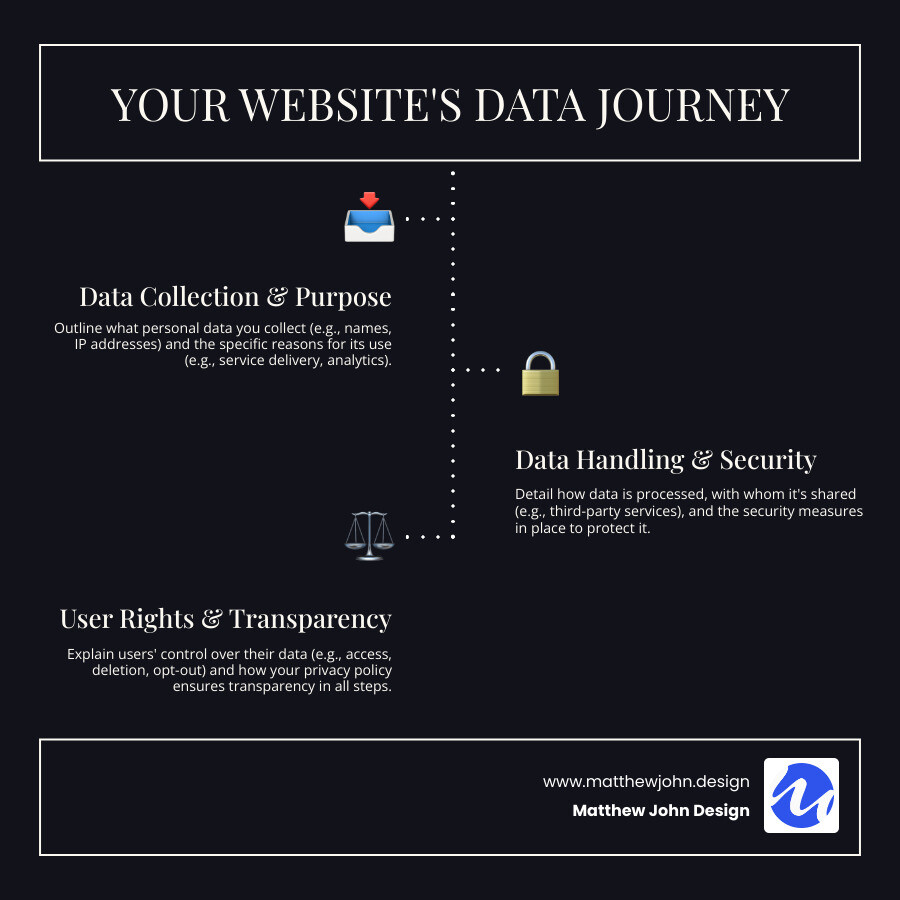Any information contained on this Website is not legal advice and should not be treated as such. You should always contact an attorney for help with your specific legal needs and issues. We may also earn a commission when you click links to our partners and purchase goods or services. For more information, read our Disclaimers Policy.
Why Your Website Can't Afford to Ignore Privacy
A standard privacy policy for websites is a legal document that tells visitors how you handle their personal information. Think of it as your website's promise to its users about their data.
A privacy policy outlines:
- What data you collect: Names, email addresses, IP addresses, or browsing habits.
- How you collect it: Through forms, cookies, or analytics tools.
- Why you collect it: For specific purposes, like providing a service or sending newsletters.
- Who you share it with: Any third-party services that might access user data.
- How you protect it: The security measures you take to keep data safe.
- User rights: The control users have over their data, like the right to access or delete it.
Trust is everything. If your website collects any user data, you need a privacy policy. It’s not just about transparency; it’s about protecting your business and building strong relationships. Consider that 48% of users have stopped buying from a company over privacy concerns, while 60% would spend more with a brand they trust with their information.
A policy also helps you meet legal requirements from laws like GDPR and CCPA. Not having one can lead to big fines—GDPR penalties can be up to 4% of a company's yearly income or €20 million.
This guide will simplify what a standard privacy policy means for your website. We’ll show you how to create one that’s compliant, transparent, and built for trust.

Basic standard privacy policy for websites vocab:
The Anatomy of a Compliant Policy: What to Include
To build trust and ensure your standard privacy policy for websites is compliant, you need to cover some essential ground. Let's break down what goes into a reassuring policy.

The essential clauses your privacy policy should include are:
- Information Collection: What data do you gather, and how?
- Purpose of Use: Why are you collecting this data?
- Data Sharing: Who else gets access to this data?
- Data Security: How do you protect the information?
- Data Retention: How long do you keep the data?
- User Rights: What control do users have over their information?
- Cookies and Tracking: How do you use technologies like cookies?
- Children's Privacy: How do you handle data from minors?
- International Data Transfers: Where does the data go if you operate globally?
- Policy Changes: How do you inform users about updates?
- Contact Information: How can users reach you with privacy concerns?
For more details on cookie-related disclosures, you can check out our Cookie Policy.
What Information You Collect and How
This part of your policy needs to be clear about what 'personal data' you gather. This can include identifiers (names, emails, IP addresses), commercial information (purchase history), internet activity (browsing behavior), and sometimes geolocation data.
Data is collected in two main ways:
- Automatic collection: Data gathered passively when someone visits your site, often through cookies, log files, or analytics tools like Google Analytics.
- User-provided data: Information actively given by a user, such as by filling out a contact form or signing up for a newsletter.
Here is an example of how you might phrase this clause:"We collect personal information you voluntarily provide when you register, express interest in our services, or contact us. This may include names, phone numbers, and email addresses. We also automatically collect certain technical information when you visit our website, such as your IP address, browser, and device characteristics. This information is primarily needed to maintain the security and operation of our website and for our internal analytics and reporting purposes."
How and Why You Use the Collected Information
Users want to know the purpose behind your data collection. Be transparent about why you need their information. Common reasons include:
- Service delivery: Processing orders or managing accounts.
- Website improvement: Analyzing user behavior to improve experience.
- Marketing communications: Sending newsletters or special offers (with consent).
- Fraud prevention and security: Protecting our systems and users.
- Legal compliance: Fulfilling our legal obligations.
Under laws like GDPR, you must also state your "legal basis" for processing data. This could be user consent, contractual necessity (to fulfill a service), or legitimate interest (a valid business reason that doesn't override user rights).
How You Share and Secure User Data
This section addresses who sees user data and how you protect it. We may share data in specific situations with:
- Service providers: Third-party partners who help us operate, such as payment processors (Stripe), analytics services (Google Analytics), cloud hosting providers, or email marketing platforms.
- Legal requirements: If required by a court order.
- Business transfers: In the event of a merger or acquisition.
Regarding security, while no method is 100% foolproof, we take significant steps to protect your information. We use encryption (like SSL), implement strict access controls, provide regular employee training on privacy, and conduct audits to fix vulnerabilities. We also define data retention periods, such as keeping web analytics for a maximum of 12 months.
Explaining User Rights and Choices
A great standard privacy policy for websites empowers users by explaining their rights. These include:
- The right to be informed and the right of access to their data.
- The right to rectification to correct inaccurate data.
- The right to erasure (the "Right to be Forgotten").
- The right to object to data processing, especially for direct marketing.
- The right to data portability and the right to restrict processing.
- The right to withdraw consent at any time.
We make it easy for users to exercise these rights, typically through a contact email or a form on our site. You can learn more about our general policies on our Disclaimers page.
Cookies, Tracking, and Children's Privacy
Your policy must also cover cookies and children's privacy.
Cookies and Tracking Technologies are small files stored on your device that help us personalize your experience, analyze traffic, and improve our site. We use different types, including necessary, analytics, functionality, and advertising cookies. We explain how users can manage or disable cookies through their browser settings. For example, visitors can often opt out of DART cookies by visiting Google's ad and content network Privacy Policy.
Children's Privacy is a top priority. We clearly state that we do not knowingly collect Personal Identifiable Information (PII) from children under 13. If we find we have done so accidentally, we will promptly delete the data. Our policy provides instructions for parents to contact us if they believe their child has shared personal information. This aligns with laws like the Children’s Online Privacy Protection Act (COPPA). For more on how major platforms use data, you can explore Google's data use policies.
Navigating the Global Maze of Privacy Laws
In today's interconnected world, your website is global, meaning your standard privacy policy for websites must comply with various international data privacy laws. Ignoring these rules can lead to hefty fines and damage your reputation.

At Matthew John Design, our global team is familiar with this complexity. Penalties are serious; GDPR fines can reach up to 4% of a company's annual income or €20 million.
The GDPR and UK GDPR: The European Standard
The General Data Protection Regulation (GDPR) is a highly influential data privacy law. It applies to any organization handling personal data from people in the EU and EEA, regardless of where the business is located. The UK GDPR is a similar version for UK users.
Key aspects of GDPR:
- Broad Scope: Protects a wide range of "personal data."
- Clear Roles: Defines Data Controllers (who decide how data is used) and Data Processors (who process data on their behalf).
- Lawful Basis: Requires a legal reason for processing data, such as consent, contract, or legitimate interest. Consent must be clear and freely given.
- Strong User Rights: Grants users rights like access, correction, and erasure ("Right to be Forgotten").
- Data Breach Notification: Mandates prompt notification of data breaches.
Understanding GDPR is essential for any website with a European audience. You can read the official text of the GDPR for more details.
CCPA/CPRA: California's Consumer Rights
California's privacy laws, the California Consumer Privacy Act (CCPA) and the California Privacy Rights Act (CPRA), give residents strong control over their data. They apply to businesses that collect personal information from Californians and meet certain thresholds.
Key aspects of CCPA/CPRA:
- Broad Definition of "Personal Information": Covers a wide range of data.
- "Do Not Sell or Share" Rights: Allows users to opt out of the sale or sharing of their personal information.
- Right to Delete and Correct: Lets users request deletion or correction of their data.
- Annual Policy Update: Requires privacy policies to be updated at least every 12 months.
- Sensitive Personal Information: Adds extra protections for a new category of sensitive data.
Due to California's large market, many businesses outside the state must comply with CCPA/CPRA.
PIPEDA and Other Key Regulations
Many other regions have their own privacy laws. As a global agency, we monitor these evolving regulations.
Here's a quick comparison of key global privacy laws:
| Feature | GDPR (EU/UK) | CCPA/CPRA (California, US) | PIPEDA (Canada) |
|---|---|---|---|
| Scope | Protects EU/UK residents' data | Protects California residents' data | Protects personal info in private sector |
| Key Principles | Lawfulness, fairness, transparency, purpose limitation, data minimization, accuracy, storage limitation, integrity, confidentiality | Right to know, delete, opt-out of sale/share, non-discrimination | Accountability, identifying purposes, consent, limiting collection, limiting use/disclosure/retention, accuracy, safeguards, openness, individual access, recourse |
| Consent Model | Opt-in (strict) | Opt-out for sale/share | Knowledge & Consent (often implied, but explicit for sensitive) |
| User Rights | Access, rectification, erasure, portability, objection, restriction | Access, deletion, opt-out sale/share, correction | Access, challenge accuracy |
| Fines | Up to €20M or 4% of global turnover | Up to $7,500 per violation (intentional) | Up to CA$100,000 for summary conviction |
| Effective Date | May 25, 2018 | Jan 1, 2020 (CCPA); Jan 1, 2023 (CPRA) | April 13, 2000 |
Other important laws include Canada's PIPEDA, Australia's Privacy Act 1988, Brazil's LGPD, China's PIPL, and India's DPDP Bill. This complex environment highlights why your standard privacy policy for websites must be robust and flexible. You can learn more about Canada's Privacy Act here.
Crafting Your Standard Privacy Policy for Websites: A Practical Guide
Now, let's get practical: how to actually create your standard privacy policy for websites. With a clear plan, you can make your policy clear, accessible, and transparent.

Best Practices for Writing a Clear Policy
Your privacy policy should be easy for users to understand, not a dense legal textbook.
- Use simple language: Avoid legal jargon. If you must use a technical term, explain it.
- Create a clear structure: Use headings, subheadings, and bullet points to make the policy easy to skim. A layered approach, with a short summary followed by detailed sections, can be effective.
- Ensure accuracy: Your policy must truthfully reflect your data practices. Regularly review your processes to ensure they align with what your policy states.
Here's an example of a clear policy introduction:"Our Commitment to Your Privacy: We respect your privacy and are committed to protecting it. This policy describes the types of information we may collect when you visit our website matthewjohn.design and our practices for collecting, using, and protecting that information. By using this Website, you agree to this privacy policy."
Where to Display Your Privacy Policy
Having a wonderfully written privacy policy is great, but it won't do much good if nobody can find it! Making your policy easy to access is a must-have under most privacy laws. You want it to be front and center, so your visitors can find it whenever they need to.
The most common and expected spot is in your website footer. A clear link to your standard privacy policy for websites should be visible on every single page of your site. This is where people naturally look for legal information.
Think about other key interaction points too. If you have sign-up forms where users provide personal details, like for a newsletter or account creation, always include a link to your privacy policy right near the submit button. For e-commerce sites, it's smart to have a link on your checkout pages, especially before customers finalize their payment. And don't forget your cookie consent banner! This is a perfect place to link directly to your privacy policy (and a separate cookie policy if you have one) so users can learn more about how cookies are being used.

The main takeaway? Make it super easy for your users to find and review your policy anytime.
Why Professional Help Matters
Creating a compliant standard privacy policy for websites can be tricky, especially for global businesses. This is where professional help is invaluable.
A generic template won't capture the specifics of your business. Professionals can create a custom-fitted policy that accurately reflects your operations. This reduces your legal risk, as a poorly written policy can lead to fines and legal challenges. Experts also help you stay current with changing laws and technologies.
At Matthew John Design, we build Webflow sites with compliance in mind from the start. We know the digital marketing world and can help you seamlessly integrate a legally solid and user-friendly privacy policy into your site.
For more helpful tips, check out our Website Policies Blog Category.
How Often to Review and Update Your Policy
Your privacy policy is a living document that needs regular attention. We recommend reviewing it at least annually, or whenever you:
- Face changes in laws.
- Introduce new business practices or collect new types of data.
- Add new third-party services that handle user data.
- Alter how you process or store data.
When you make significant changes, notify your users via an email, a note in the policy, or a pop-up on your website.
Frequently Asked Questions About Website Privacy Policies
Here are answers to some of the most common questions we hear from website owners.
Can I just copy another website's privacy policy?
No, please don't! It's a tempting shortcut, but it's a recipe for trouble.
- Copyright: Privacy policies are often copyrighted legal documents. Copying one can lead to plagiarism claims.
- Inaccuracy: Every website's data practices are unique. A copied policy will not accurately reflect your operations, from the data you collect to the third-party services you use.
- Legal Risk: An inaccurate policy leaves you non-compliant and vulnerable to fines and lawsuits.
Your policy must be custom to your specific business.
Is a free privacy policy template enough?
A free template can be a starting point for a very simple website with minimal data collection (like a personal blog). However, for most businesses, templates have significant limitations.
- Lack of Customization: They are generic and often fail to cover your specific data practices, third-party tools, or the laws relevant to your global audience.
- Risk of Non-Compliance: A template might not meet all the requirements of complex laws like GDPR or CCPA, leaving you exposed.
- Not Legal Advice: Templates provide a framework but don't replace professional legal assessment of your obligations.
For most businesses, a custom policy crafted by professionals is the safest and most effective approach to ensure your standard privacy policy for websites is comprehensive and compliant.
What happens if I don't have a privacy policy?
Operating without a privacy policy is a major risk. The consequences can be severe:
- Legal Penalties and Fines: Laws like GDPR impose massive fines (up to 4% of global revenue or €20 million). Many other jurisdictions have similar penalties.
- Loss of Customer Trust: In today's privacy-conscious world, a missing policy signals that you don't respect user data, driving customers to competitors.
- Banned from Third-Party Services: Many essential platforms like Google AdSense, Google Analytics, and app stores require a compliant policy. Without one, you could be cut off.
- Reputational Damage and Lawsuits: Data privacy violations can lead to negative press, a tarnished brand, and legal action from individuals or consumer groups.
In short, not having a standard privacy policy for websites is a gamble not worth taking for any legitimate online business.
Conclusion: From Compliant to Confident
We've covered a lot, but the main takeaway is simple: a standard privacy policy for websites is a non-negotiable part of doing business online today.
View your privacy policy as an opportunity to build trust. It comes down to a few core ideas: privacy is a user right, transparency builds trust, and proactive compliance is key to avoiding costly fines and reputational damage. Your policy is a living document that requires regular review and updates to keep pace with changing laws and business practices.
At Matthew John Design, we empower businesses by crafting beautiful, functional Webflow sites built on a foundation of trust and compliance. Our expertise in web development and SEO ensures every aspect of your digital footprint is robust and trustworthy.
Don't let data privacy complexities overwhelm you. See it as a chance to strengthen your brand and connect more deeply with your audience.

